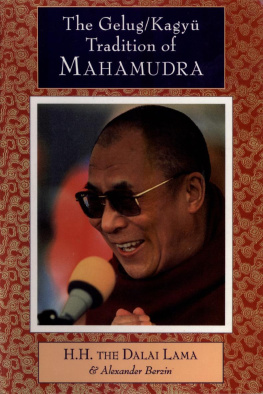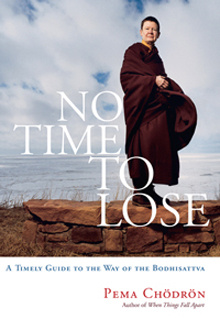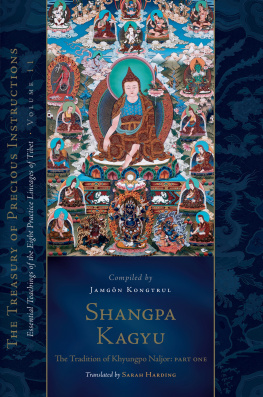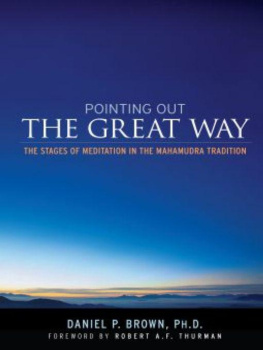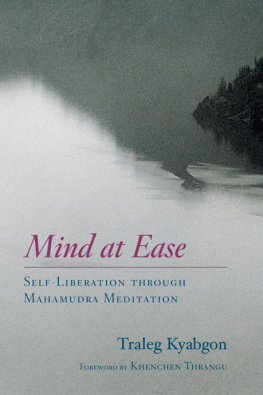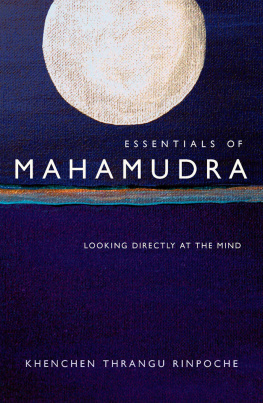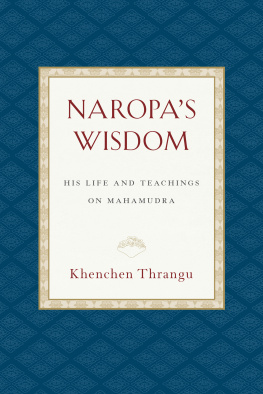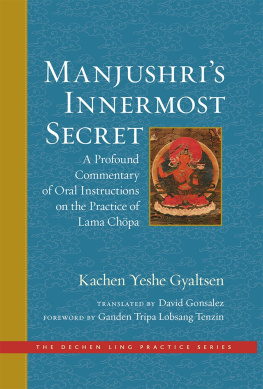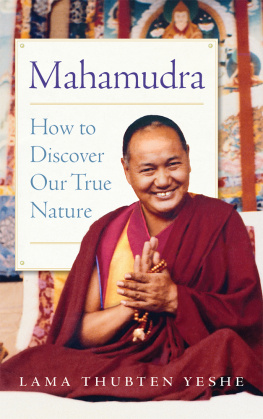
Snow Lion
An imprint of Shambhala Publications, Inc.
4720 Walnut Street
Boulder, Colorado 80301
www.shambhala.com
1997 by Alexander Berzin
Special thanks to Paul Hackett for supplying a Tibetan copy of the First Panchen Lamas root text.
All rights reserved. No part of this book may be reproduced in any form or by any means, electronic or mechanical, including photocopying, recording, or by any information storage and retrieval system, without permission in writing from the publisher.
Cover photo: Bill Warren
Cover design: Sidney Piburn/Jesse Townsley
Library of Congress Cataloging-in-Publication Data
Bstan- dzin-rgya-mtsho, Dalai Lama XIV, 1935
The Gelug/Kagy tradition of Mahamudra / by H.H. Tenzin Gyatso and Alexander Berzin.1st ed.
p.cm.
Translated from Tibetan.
Includes the text of Blo-bza-chos-kyi-rgyal-mtshans Dge-ldan bka brgyud rin po chei phyag chen rtsa ba rgyal bai gu lam.
Includes indez.
ISBN 9781559390729
eISBN9781559399302
1. Blo-bza-chos-kyi-rgyal-mtshan, Panchen Lama I, 1567?1662. Dge-ldan bka brgyud rin po chei phyag chen rtsa ba rgyal bai gu lam. 2. Mahmudr (Tantric rite). 3. Dge-lugs-pa (Sect)Rituals. 4. Bkargyud-pa (Sect)Rituals. I. Berzin, Alexander. II. Blo-bza-chos-kyi-rgyal-mtshan, Panchen Lama I, 1567?1662. Dge-ldan bka brgyud rin po chei phyag chen rtsa ba rgyal bai gu lam. III. Title.
294.344dc21
96-48435
CIP
v4.1
a
Table of Contents
Preface
The present book has evolved through a long history. At the suggestion of His Holiness the Fourteenth Dalai Lama, I initially translated the First Panchen Lamas A Root Text for the Precious Gelug/Kagy Tradition of Mahamudra in 1973, with the help of Sharpa Rinpochey, Khamlung Rinpochey and Jonathan Landaw, based on an explanation by Geshey Ngawang Dhargyay. Originally published as A Root Text on Mahamudra: The Great Seal of Voidness (Dharamsala: Library of Tibetan Works & Archives, 1974), it was reprinted in Four Essential Texts (Dharamsala: Library of Tibetan Works & Archives, 1982).
On June 10, 1978, His Holiness, at the request of the late Ven. Anne Ansermet, delivered a discourse on this text in Dharamsala, India, to a small private group of especially interested disciples. Subsequently, with the help of Ven. Lobsang Rabgyay, I translated these teachings from the tape cassettes into English, which then formed the basis for a French translation prepared by Madame Ansermet. This French version was published as Meditation sur lesprit , par le 14 e Dalai Lama (Paris: Dervy-Livre, Coll. mystique et religion srie B, 1982).
From March 18 to 22, 1982, His Holiness, requested by the late Lama Thubten Yeshe, delivered in Dharamsala a public discourse on the First Panchen Lamas auto-commentary to his root text. I translated the lectures orally, with the occasional assistance of Ven. Georges Dreyfus. For years, cassettes of these teachings were unavailable to me. In 1995, however, Kaitlin Collins located a copy of them and prepared a transcription of the English translation. Encouraged by this, I requested Ven. Thubten Chodron to key into the computer the handwritten version of my English translation of His Holinesss first discourse, to which she kindly consented.
At the request of Sidney Piburn of Snow Lion Publications, I have completely retranslated the First Panchen Lamas root text and His Holinesss two discourses and edited them for publication. I have incorporated into the flow of the discourses His Holinesss answers to questions asked at the end of each session, as well as elaboration and clarification of points, persons and texts mentioned in abbreviated form, drawing from other teachings by His Holiness and Tibetan reference works. The root text appears as Part Two of the present volume, while His Holinesss teaching on it as Part Three and his explication of the auto-commentary as Part Four. As an introduction to the subject matter, I have added, as Part One, an edited, expanded version of a set of lectures on mahamudra meditation I delivered from November 7 to 8, 1995, at the Aryatara Institute in Munich, Germany, at the request of Alnis Grants.
I have used a system of translation terminology initially developed under the guidance of my root guru, the late master debate partner of His Holiness, Tsenzhab Serkong Rinpochey, and which I have refined over the last seventeen years by experimentation and use. It is designed to help overcome obstacles to understanding due to jargon that has become meaningless. For ease of reading for non-specialists, I have used a simplified phonetic transliteration system for Sanskrit and Tibetan names and terms. Their standard transcription, as well as the Tibetan, and Sanskrit when available, for the titles of cited texts and major technical terms specific to the subject matter, occasionally along with their more common translation, are included in the indices.
Rajinder Kumar Dogra kindly provided me with the facilities in Bangkok, Thailand, for a two-month intensive work retreat during the rainy season, 1996, to prepare this book. I acknowledge his and my Snow Lion editor, Susan Kysers, helpful suggestions for improving its style and language. I worked on the final draft during the autumn of 1996 at various places on an extensive lecture tour of the Middle East, the former Soviet Central Asian Republics and Mongolia, during which I was kindly given facilities to work by many universities and private individuals. Bakula Rinpochey, the Indian ambassador to Mongolia, generously offered me his time to clarify certain obscure points. In the end, the research staff of the Library of Tibetan Works & Archives, in Dharamsala, India, provided me with further textual resources and details for finalizing the text. The pre-publication process was initiated by donations made by Edith Erbacher and several other persons who attended the meditation courses I taught in Western Europe during the spring of 1996, and then funded by a grant from the Kapor Family Foundation. I gratefully acknowledge the support of all of them. This book thus exists by virtue of its having arisen dependently on the kindness of many. By the positive potential of the joint efforts and contributions of all these people, may everyone attain to enlightenment for the benefit of all.
Alexander Berzin
Dharamsala, India
December 5, 1996
Part I
AN INTRODUCTION TO MAHAMUDRA AND ITS PRACTICAL APPLICATION TO LIFE
Chapter One
THE BUDDHIST FRAMEWORK
OVERVIEW OF THE TOPIC
Mahamudra is a Sanskrit word meaning great seal and refers to the nature of all phenomena. Just as a wax seal is stamped on legal documents to authenticate their signature, likewise the nature of reality is figuratively stamped upon everything as a guarantee that nothing exists in a fantasized, impossible way. The fact that everything is devoid of existing in any impossible manner thus validates that things actually exist.
Mahamudra also refers to sophisticated Buddhist systems of meditation and practice to realize this great sealing nature. The distinctive characteristic of these techniques is to see this nature by focusing on mind itself and discovering the relationship between mind and reality. When our mind confuses reality with fantasy, we produce problems for ourselves. Furthermore, when our mind gives rise to an appearance of others in a way that does not correspond to their reality, we are unable to be of help to them. Understanding the intimate relation between mind and reality, therefore, is essential for achieving both liberation and enlightenment, the goal of mahamudra practice.
The most commonly discussed fantasized and impossible manner of existence in Buddhism is literally called true existence, referring to existence truly independent from a relation with mind. Since true existence is, paradoxically, false existence, referring to a manner of existence that is impossible and not at all real, we can perhaps avoid the confusion by using, instead, variations of the term solid existence.
Next page
